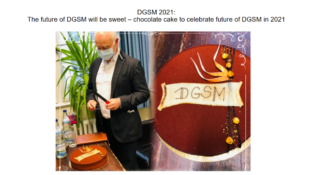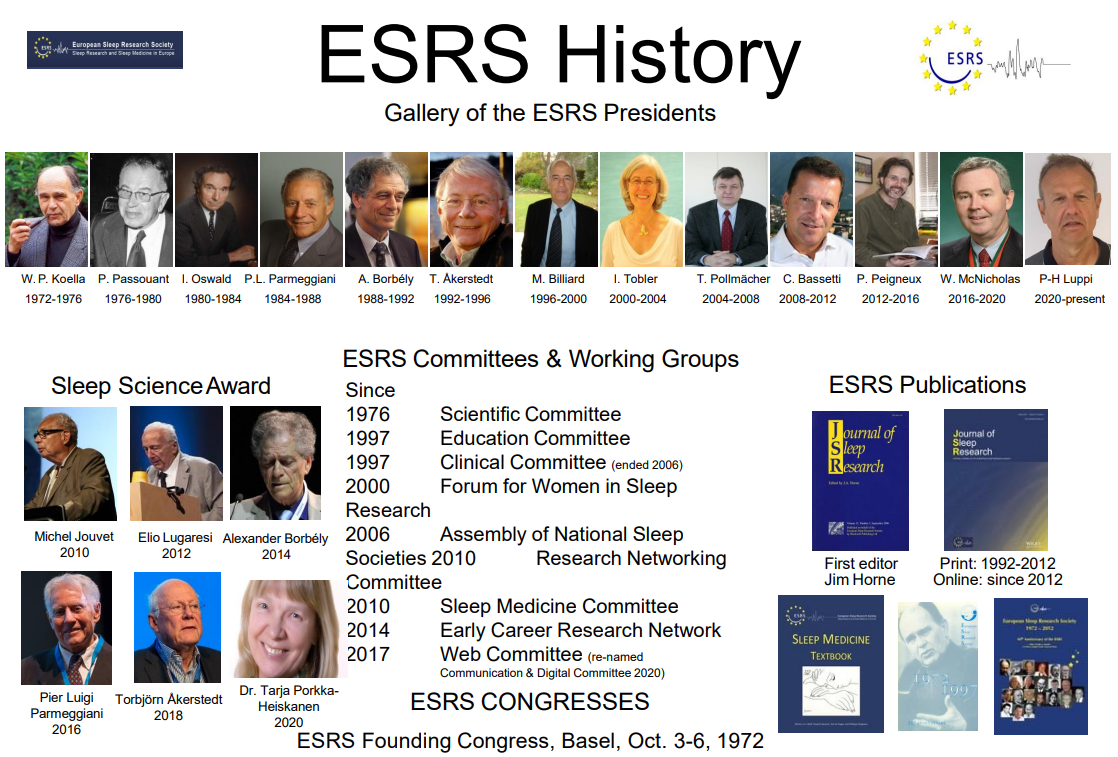Sleep Science Friday: Sleep monitoring and sleep measurement – “Be careful, be critical, but be open!”
Sleep Science Friday
29 January 2021
“Be careful, be critical, but be open” when choosing a device for sleep monitoring, says Professor Thomas Penzel, President of the German Society for Sleep Research and Sleep Medicine.
The guest today is Professor Thomas Penzel, Scientific Chair of Sleep Center Charité – Universitätsmedizin Berlin, a specialist in physics, human biology and physiology and leading expert in biomedical signals processing. In November 2020, Professor Thomas Penzel was elected President of the German Society for Sleep Research and Sleep Medicine (Deutsche Gesellschaft für Schlafforschung und Schlafmedizin, DGSM) and today he shares the news in the sleep field in Germany.
Sleep assessment is the basic procedure for any sleep research or clinical investigation of sleep disorders. It is essential therefore to choose the right method. Polysomnography remains the gold standard or reference method for the quantitative assessment of sleep. At the same time, the digitalization and a burst in technology development brought countless numbers of various devices which allow for sleep measurement. Sleep stages and other sleep parameters can be derived and calculated from a variety of measurements, such as ECG/heartbeat, respiration, photoplethysmography, ocular signals, tracheal sounds, or snoring.
These novel digital-based devices include a wide spectrum of devices varying from wearable portable cardiorespiratory tools and multimodal wireless sensor systems to smart watches, rings, hats, belts, patches, and temperature (micro)sensors, smart mattresses etc, that can be used not only for sleep assessment, but also for monitoring the compliance to therapeutic interventions. All these aim to make it easier and more comfortable for patients to use, as well as at making long-term and remote sleep monitoring possible. These novel sleep digital-based diagnostics techniques are expected to improve personalized health care and is one of the goals of the Sleep Revolution project, described in the interview with Dr. Erna Sif Arnardottir. Integrated in digital medicine these devices can help to fill the gap of low accessibility of polysomnographic studies.
These documents accelerated the adoption of telehealth, which were so important in the era of COVID-19 and allowed for the wide implementation of telemedicine services, including primary video consultations. Large-scale reimbursements also became possible for evidence-based digital sleep applications which provide the opportunity for sleep screening in large populations. Thus, in Germany, approved digital applications are now prescribed as any other medical procedure, showing a promising example of integration of e-medicine into everyday clinical practice. Germany has anticipated the urgent need for telemedicine services, and in 2019, the German government approved the Digital Healthcare Act (Digitale-Versorgung-Gesetz or DVG (2019), which regulates the reimbursement for certain digital health applications. Later, in April 2020, another legislative document – the Digital Health Applications Ordinance (Digitale Gesundheitsanwendungen-Verordnung—DiGAV) came into force. This regulates the procedure and requirements for reimbursement eligibility of digital health applications.
However, Professor Thomas Penzel emphasizes the importance of distinguishing medical and consumer products and warns us to be cautious when choosing a device for sleep monitoring: “Be careful, be critical, but be open to those with strong validation!”. He personally believes that one only can rely on the tools that are tested against full pomnography (Video 1: 13:12)
One of the promising technologies already approved in Germany for clinical use is based on the peripheral arterial tonometry (PAT) method. In the video below, Professor Thomas Penzel gives a clear and comprehensive explanation of how this method works for sleep measurements, including in patients with atrial fibrilation and what its limitations are. He shares his experience of using this technology and future perspectives for PAT application.
 Professor Thomas Penzel mentions prospective changes which have been observed in the sleep-related community in Germany in the last few years (video 1 06:02). The number of members of the DGSM is not increasing, due to the large involvement of GPs in sleep diagnostics and treatment. Therefore, the Society encounters the need for changing the role of the society and its restructuring, as well as the need for changes in the educational system of the somnology field. Possible approaches include higher involvement and education of sleep technicians. These issues will be discussed at the Workshop “Future of Sleep Medicine” which is planned to be held in June 2021.
Professor Thomas Penzel mentions prospective changes which have been observed in the sleep-related community in Germany in the last few years (video 1 06:02). The number of members of the DGSM is not increasing, due to the large involvement of GPs in sleep diagnostics and treatment. Therefore, the Society encounters the need for changing the role of the society and its restructuring, as well as the need for changes in the educational system of the somnology field. Possible approaches include higher involvement and education of sleep technicians. These issues will be discussed at the Workshop “Future of Sleep Medicine” which is planned to be held in June 2021.
We are continuing to share e-lessons on sleep physiology. What is the choreography of sleep? How does EEG power spectrum analysis help to assess sleep structure? Is immobility equal to sleep? Are methods such as infrared beam brake and visual movement detection applicable for sleep detection? How do you choose a stimulus for a sleep deprivation study?
Professor Tarja Porkka-Heiskanen (University of Helsinki, Finland) answers them in this 12-minute comprehensive e-lecture.
Do not miss out on the call for 2021 ESRS Fellowship, Meeting Fellowships and Training Grant Applications to support early career researchers within Europe. The deadline for applications is 31 January 2021.
Latest publications from ESRS members:
1. Trzepizur W, Cistulli PA, Glos M, Vielle B, Sutherland K, Wijkstra PJ, Hoekema A, Gagnadoux F. Health Outcomes of Continuous Positive Airway Pressure versus Mandibular Advancement Device for the Treatment of Severe Obstructive Sleep Apnea: an Individual Participant Data Meta-analysis. Sleep. 2021 Jan 25:zsab015. doi: 10.1093/sleep/zsab015.
2: Duss SB, Brill AK, Baillieul S, et al. Effect of early sleep apnoea treatment with adaptive servo-ventilation in acute stroke patients on cerebral lesion evolution and neurological outcomes: study protocol for a multicentre, randomized controlled,rater-blinded, clinical trial (eSATIS: early Sleep Apnoea Treatment in Stroke). Trials. 2021 Jan 22;22(1):83. doi: 10.1186/s13063-020-04977-w.
3: Deviaene M, Castro I, Borzée P, Patel A, Torfs T, Buyse B, Testelmans D, Van Huffel S, Varon C. Capacitively-coupled ECG and respiration for the unobtrusive detection of sleep apnea. Physiol Meas. 2021 Jan 22. doi: 10.1088/1361-6579/abdf3d.
4: Muñoz-Lopetegi A, Berenguer J, Iranzo A, Serradell M, Pujol T, Gaig C, Muñoz E, Tolosa E, Santamaría J. Magnetic resonance imaging abnormalities as a marker of multiple system atrophy in isolated rapid eye movement sleep behavior disorder. Sleep. 2021 Jan 21;44(1):zsaa089. doi: 10.1093/sleep/zsaa089.
5: Toschi N, Passamonti L, Bellesi M. Sleep quality relates to emotional reactivity via intracortical myelination. Sleep. 2021 Jan 21;44(1):zsaa146. doi: 10.1093/sleep/zsaa146. PMID: 32770244.
6: Muto V, Koshmanova E, Ghaemmaghami P, Jaspar M, Meyer C, Elansary M, Van Egroo M, Chylinski D, Berthomier C, Brandewinder M, Mouraux C, Schmidt C, Hammad G, Coppieters W, Ahariz N, Degueldre C, Luxen A, Salmon E, Phillips C, Archer SN, Yengo L, Byrne E, Collette F, Georges M, Dijk DJ, Maquet P, Visscher PM, Vandewalle G. Alzheimer’s disease genetic risk and sleep phenotypes in healthy young men: association with more slow waves and daytime sleepiness. Sleep. 2021 Jan 21;44(1):zsaa137. doi: 10.1093/sleep/zsaa137.
Do not miss the date and subscribe for the 2021 Examination in Sleep Medicine to become a certified expert in sleep medicine! The on-line application is already open on this website.
Not an ESRS member yet? Apply here and see our wide range of benefits, including a yearly online subscription to the Journal of Sleep Research, automatic membership to the Federation of European Neuroscience Societies (FENS), support for early career researchers via the ECRN, regular updates via the ESRS Newsletter, promotion of your research, and more.




